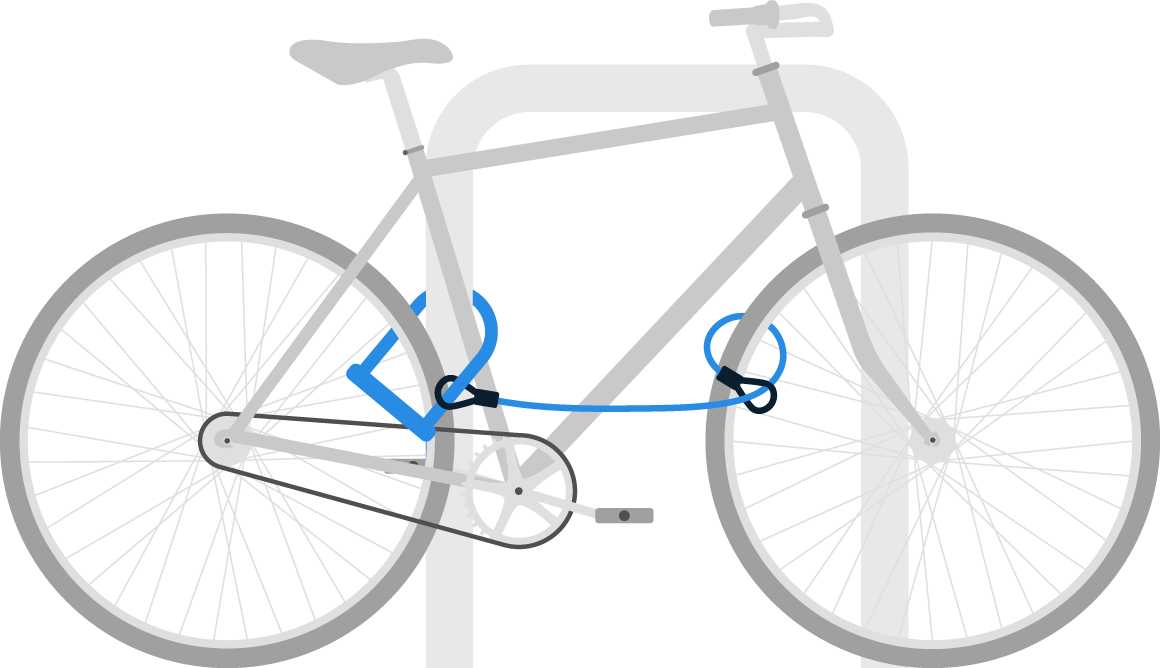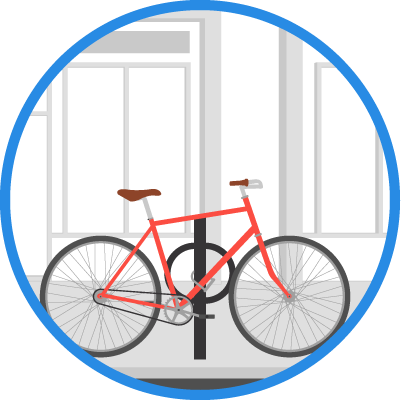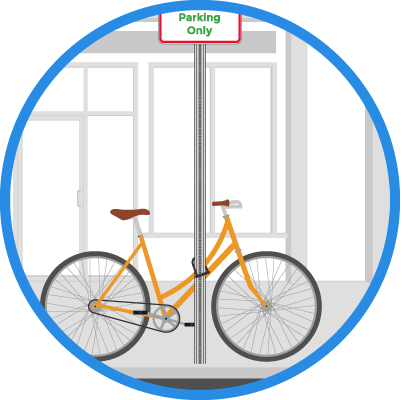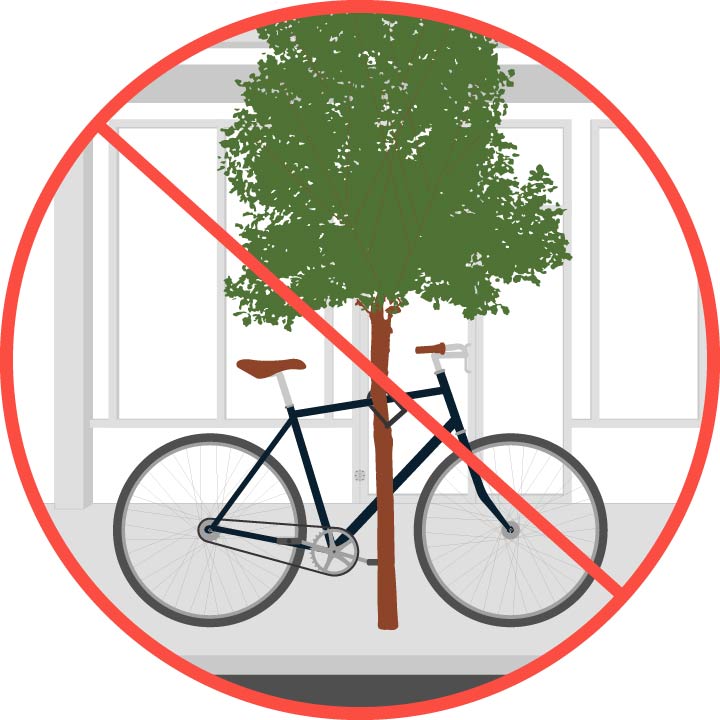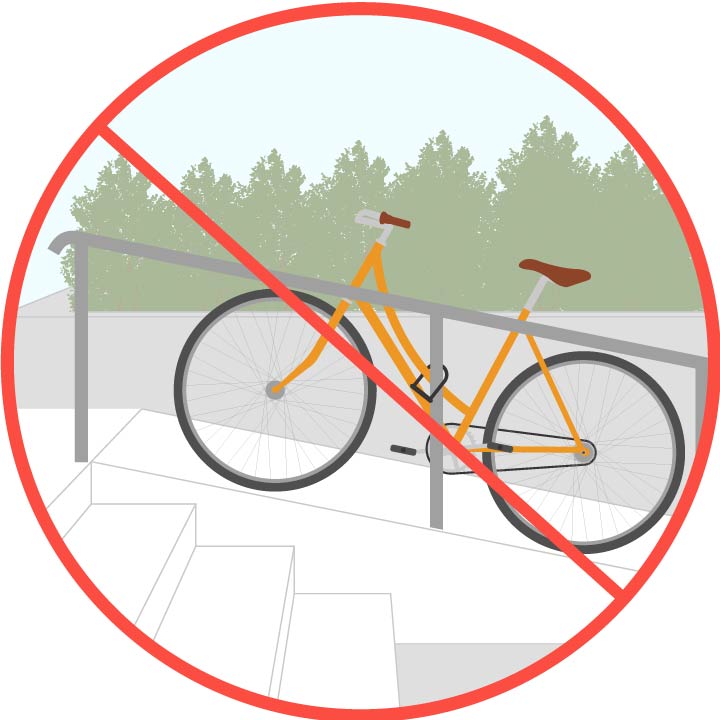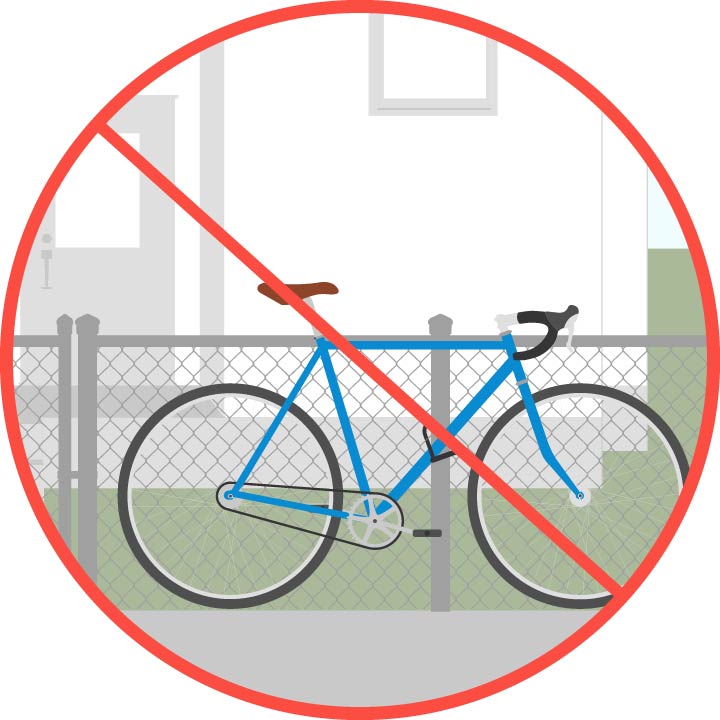Park your bike
Whenever you secure your bike on a sidewalk, you must leave at least four feet (4') of clearance for pedestrians. Never block access to sidewalks, curb ramps, crosswalks, fire hydrants, bus stops, accessible parking spaces, or loading zones.
It’s best to store your bike in a secure and covered area, like in a garage that’s monitored by security. If that’s not possible, aim for a visible area with a lot of foot traffic.
Remember to take any parts that are easy to remove, such as lights, with you. Someone else may take them if you don’t.
Note: These guidelines only apply to human-powered vehicles (bicycles). Motor vehicles, of any kind, may not be parked on the sidewalk. For more details about parking motor vehicles, including scooters, please refer to the Traffic Rules and Regulations.
How to lock your bike
USE A U-LOCK
Always use a U-lock as your primary lock. Cable locks can easily be cut, and should only be used as secondary locks to secure wheels.
LOCK THE FRAME FIRST
Always secure your frame. If your bike is only secured by the wheel, a thief can walk away with the frame. Consider locking your wheels with a second cable lock or a second U-lock.
Where to lock your bike
To a bike rack
Whenever possible, lock your bike to a bike rack. Make sure your bike is parallel to the rack and that it does not prevent people from using the sidewalk. If there’s another bike parked at the rack, make sure not to accidentally lock the other bike with yours!
To some sign posts
You may lock your bike to a sign post, except for those used to designate accessible parking (HP-V) spaces, loading zones, or bus stops. Make sure your bike is parallel to the pedestrian path of travel and that it does not prevent people from using the sidewalk.
Where not to lock your bike
To a tree
Trees are not a secure place to lock your bike. A thief could cut the tree down.
Locking your bike to a tree could mean fewer healthy trees in our City. Bike locks can damage or even kill trees if left in place for too long.
To handrails
Locking your bike to handrails or a ramp can prevent people, especially those who are using wheelchairs or strollers, from getting past your bike.
Many handrails are also private property.
To private property
If you lock your bike to private property, you should have permission from the property owner. Otherwise, it is within their rights to remove your bike without notice.

FIND A RACK
Long-term storage
If you want to store your bike in your home, there are many solutions that will allow you to store your bike in a small space. Your local hardware store will have the necessary hardware. Look online for other bicycle storage solutions.
Check with the property manager at your school, employer, place of worship, or apartment building, to see if there are any spaces that can be turned into bike rooms. Always lock your bike when leaving it in shared spaces.
Our bike rack program
We want everyone to have a safe and convenient place to park their bike — at their residence, place of employment, school, or other everyday destination.
Suggest a location
The Boston Transportation Department (BTD) serves bicyclists in the City. We install and repair roughly 150 bike racks on City sidewalks each year. Learn more about our rack program.
You can help us locate the best places for these racks by submitting a request through this form. We will review your requests on a rolling basis. We prioritize racks in commercial corridors and in partnership with civic institutions, such as libraries and community centers.
Report a broken rack
Report broken bike racks via BOS:311:
- online by using the general request form
- over the phone by dialing 3-1-1 from any phone within Boston, or
- via the mobile app by using the "Other" category found under "General."
If you are reporting the rack online or via the mobile app, please include a picture of the rack that shows what's behind it. This helps us locate the rack that needs to be repaired.
Other Boston by Bike sections
Boston by Bike
An overview of the Boston by Bike guide.
Choose a bike
We've provided information to help you find a bike that's right for you!
Get accessories
We've provided information about some of the most common items that you might want to add to your bike, or get for yourself.
Plan a route
We've provided information to help you figure out the best routes for bike trips. This includes info about taking your bike on the T.
Ride your bike
Here's what to do before each ride, how to ride on Boston's streets, and tips for riding in different weather conditions.
Park your bike
This is the current page.
Fix your bike
Learn how to repair your bike or just get a tuned up.
Report a problem, learn the laws
We've summarized information about how to report a bike-related problem and included a summary of the Mass. General Laws about biking.
(Women) learn to ride
We spread the joys of biking and encourage more women and gender-nonconforming people to travel by bike.

